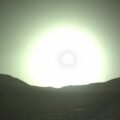Two new minerals that have never been discovered on earth before have just been found hidden inside a meteorite. As the ninth largest meteorite ever found, which plummeted from space and smashed into the ground in Somalia, the space rock hiding the pair of minerals may help investigators discover completely new processes that formed the minerals, as well as fuel research by materials scientists. And the researchers behind the once-of-a-kind discovery say there may be even more undiscovered minerals hiding inside the history-making meteorite.
“Whenever you find a new mineral, it means that the actual geological conditions, the chemistry of the rock, was different than what’s been found before,” says Chris Herd, a professor in the Department of Earth & Atmospheric Sciences, curator of the University of Alberta’s Meteorite Collection and part of the t4m that made the unique finds. “That’s what makes this exciting: In this particular meteorite, you have two officially described minerals that are new to science.”
According to a press release from the University of Alberta, where scientists stumbled upon the extraterrestrial minerals, they were found within a single 70-gram slice of the space rock. As the researcher in charge of the discovery, Herd won the privilege to officially name the two new space minerals. The first he has officially named “elaliite” because it was found near the town of El Ali, in the Hiiraan region of Somalia.
Herd wisely named the second mineral “elkinstantonite” after the vice president of the ASU Interplanetary Initiative (and his boss), Lindy Elkins-Tanton. The release notes that Elkins-Tanton is also a professor at Arizona State University’s School of Earth and Space Exploration and principal investigator of NASA’s upcoming Psyche mission.
“Lindy has done a lot of work on how the cores of planets form, how these iron-nickel cores form, and the closest analog we have are iron meteorites,” Herd explained of his second choice. “So it made sense to name a mineral after her and recognize her contributions to science.”
Working with researchers at UCLA and the California Institute of Technology, Herd classified the space rock itself as an “Iron, IAB complex” meteorite, one of 350 known samples of that type. However, when analyzing the meteorite more closely, Herd saw something he didn’t quite recognize. He immediately reached out to his colleague Andrew Locock, who is the head of the U of A’s Electron Microprobe Laboratory and also someone who has been part of naming previously discovered extraterrestrial minerals not found on earth.
“The very first day he (Locock) did some analyses, he said, ‘You’ve got at least two new minerals in there,’” recounted Herd. “That was phenomenal. Most of the time, it takes a lot more work than that to say there’s a new mineral.”
Fortunately for the researchers involved, the two new minerals had actually been previously synthesized in a laboratory setting, so Locock was able to quickly match their composition to the fabricated ones.
Herd notes that along with naming the two new minerals, the most rewarding part of his work is trying to back-engineer the unique processes and conditions that must have existed somewhere outside of our home planet to create the never before seen minerals.
“That’s my expertise,” he explained, “how you tease out the geologic processes and the geologic history of the asteroid this rock was once part of.”
It’s an honor and privilege the professor says he never even hoped for in his career. “I never thought I’d be involved in describing brand new minerals just by virtue of working on a meteorite.”
In his presentation of the newly discovered minerals at the U of A Space Exploration Symposium on November 21st, Herd says that materials scientists are likely to take a keen interest in his work with the new mineral.
“Whenever there’s a new material that’s known, material scientists are interested too because of the potential uses in a wide range of things in society,” he explained.
Unfortunately, Herd is not sure he will get the chance to follow up on naming the two new minerals. That’s because the privately-owned space rock has been moved to China, where the owner is allegedly hunting for a potential buyer. Still, the researchers behind the historic find are holding out hope that samples of the meteorite will be made available for future study. Let’s hope they’re right.
Follow and Connect with Author Christopher Plain on Twitter @plain_fiction

